1. Research and development 2019
1.1. Majority of R&D personnel in the higher education sector are women, in enterprises only one in five
In 2019, altogether 76,200 persons were employed in research and product development tasks, one-half of them in enterprises. The total number of R&D personnel increased by 2,300 from the year before, that is, by three per cent. Enterprises’ R&D personnel increased by four per cent and that of the higher education sector by good three per cent, while R&D personnel in the government sector contracted by one per cent. The proportion of women in R&D personnel remained unchanged and stood at 35 per cent. The share of women varies by sector, as in enterprises only one in five R&D employees was a woman, in the government sector the share of women was 47 per cent and in the higher education sector 51 per cent. Seventy-six per cent of the R&D personnel were researchers and R&D engineers, while the rest were engaged in various expert or support tasks related to R&D activity.
R&D personnel are highly educated, one in five has a doctorate level degree, in addition, two-thirds have other university or polytechnic degrees.
R&D in full-time equivalents amounted to 51,500 in 2019. The number increased by 1,500 full-time equivalents from the previous year, which translates to a three per cent growth. As with R&D personnel, R&D in full-time equivalents grew in enterprises and the higher education sector (3.5%) but decreased by two per cent in the government sector. Fifty-eight per cent of the full-time equivalents were carried out in enterprises, 33 per cent in the higher education sector and the remaining nine per cent in the government sector.
Figure 1. R&D personnel and R&D in full-time equivalents in 2012 to 2019
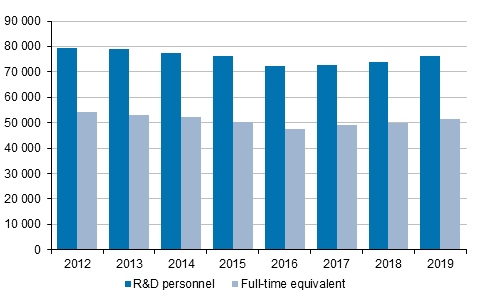
1.2. R&D expenditure grew by four per cent
The total sum of research and product development expenditure was EUR 6,715 million in 2019, which is EUR 277 million more than in the year before. In all, expenditure grew by 4.3 per cent. Growth occurred in all sectors, five per cent in the higher education sector, four per cent in enterprises and 2.6 per cent in the government sector from 2018. R&D expenditure is estimated 1) to grow in 2020 by around EUR 115 million to some EUR 6.8 billion. The GDP share is estimated to be 2.9 per cent.
Table 1. Research and development expenditure by sector and share of gross domestic product in 2011 to 2019 and an estimate for the year 2020
| Year | Sector | Total | Share of R&D in GDP 2) | ||||||
| Business enterprise sector | Government sector 1) | Higher education sector | |||||||
| EUR mil. | % | EUR mil. | % | EUR mil. | % | EUR mil. | % | % | |
| 2011 | 5 047.4 | 70.5 | 684.4 | 9.6 | 1 431.8 | 20.0 | 7 163.7 | 100 | 3.62 |
| 2012 | 4 695.0 | 68.7 | 662.2 | 9.7 | 1 474.6 | 21.6 | 6 831.9 | 100 | 3.40 |
| 2013 | 4 602.4 | 68.9 | 643.6 | 9.6 | 1 438.1 | 21.5 | 6 684.2 | 100 | 3.27 |
| 2014 | 4 409.5 | 67.7 | 613.1 | 9.4 | 1 489.5 | 22.9 | 6 512.1 | 100 | 3.15 |
| 2015 | 4 047.3 | 66.7 | 543.1 | 8.9 | 1 480.5 | 24.4 | 6 070.9 | 100 | 2.87 |
| 2016 | 3 901.7 | 65.8 | 534.6 | 9.0 | 1 489.8 | 25.1 | 5 926.1 | 100 | 2.72 |
| 2017 | 4 028.3 | 65.3 | 577.7 | 9.4 | 1 567.2 | 25.4 | 6 173.2 | 100 | 2.73 |
| 2018 | 4 226.9 | 65.7 | 587.2 | 9.1 | 1 623.8 | 25.2 | 6 437.9 | 100 | 2.76 |
| 2019 | 4 407.9 | 65.6 | 602.6 | 9.0 | 1 704.6 | 25.4 | 6 715.1 | 100 | 2.79 |
| 2020 3) | 4 477.8 | 65.6 | 607.7 | 8.9 | 1 744.4 | 25.5 | 6 829.9 | 100 | 2.94 |
2) GDP 2017-2019 Statistics Finland preliminary figures, GDP 2020 forecast of Ministry of Finance.
3) Estimate based on survey responses and other calculations.
Enterprises account for 66 per cent of R&D expenditure and domestic enterprises for 53 per cent of funding of expenditure. The government sector, in turn, is responsible for nine per cent of the expenditure, but in funding the share of central government and other public institutions is 30 per cent and that of private non-profit activities close on two per cent. The significance of the higher education sector as a provider of funds is one per cent, the share from abroad is 15 per cent.
Figure 2a. Distribution of R&D expenditure by performer sector in 2019
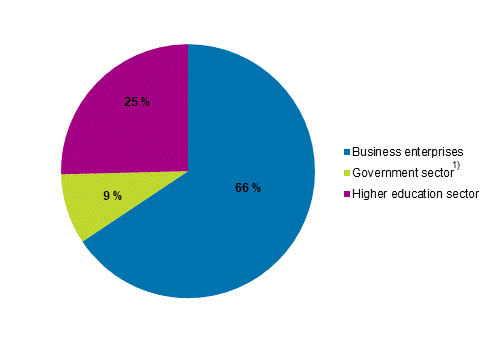
1) Government administrative, municipalities, social security funds and institutions as well as private non-profit institutions.
Figure 2b. Distribution of R&D expenditure by funding sector in 2019
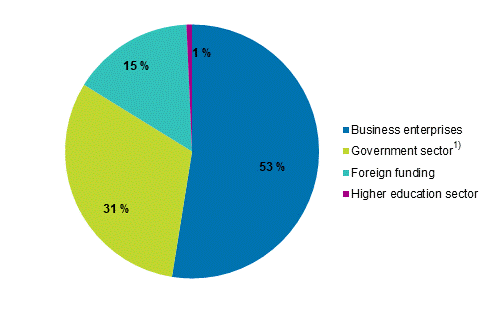
1) Government administrative branches, municipalities, social security funds and institutions as well as private non-profit institutions.
In the OECD’s comparison, Finland’s GDP share of R&D expenditure was 2.76 per cent in 2018. The decline in the GDP share ended in 2017, and there was a slight rise in 2018. Finland's GDP share of R&D expenditure is higher than the average for the OECD and EU countries. Of the European Union’s gross domestic product, 2.03 per cent was spent on research and development in 2018. The corresponding share for the OECD area was 2.38 per cent. Based on the data for 2018, the most R&D intense countries in the OECD area are Israel (4.9%) and South Korea (4.5%). The GDP share of R&D expenditure in Sweden and Finland were still on the same level in 2014 but since then while Finland’s expenditure has declined the development in Sweden has been more even and the GDP share is clearly higher than Finland’s, i.e. 3.3 per cent in 2018. 2)
Figure 3a. GDP share of R&D expenditure in certain European countries in 2013 to 2018
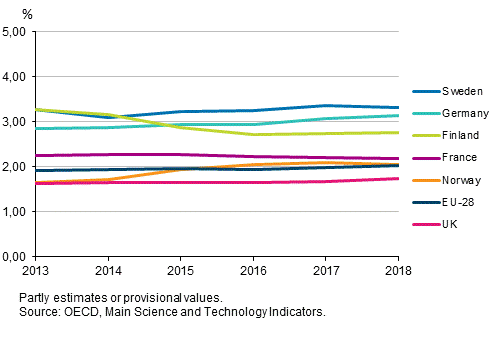
Figure 3b. GDP share of R&D expenditure in certain OECD and other countries in 2013 to 2018
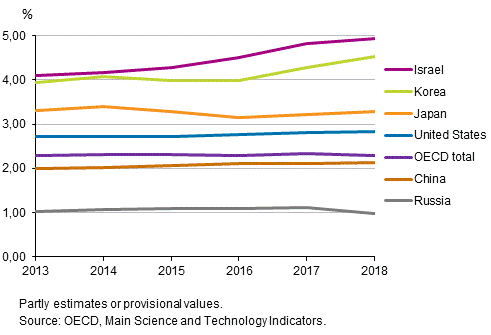
1.3. Significance of higher education institutions on region’s research input high in Northern and Eastern Finland
The expenditure of R&D practised in the region of Uusimaa amounted to EUR 3.3 billion in 2019, which is roughly one-half of R&D expenditure in the whole country. R&D expenditure in Pirkanmaa was EUR 740 million and in North Ostrobothnia EUR 730 million, the share of both regions of expenditure in the whole country was around 11 per cent. Including Southwest Finland, the share of the four biggest regions was nearly 80 per cent of R&D expenditure in the entire country.
Figure 4. Distribution of R&D expenditure by region in 2019
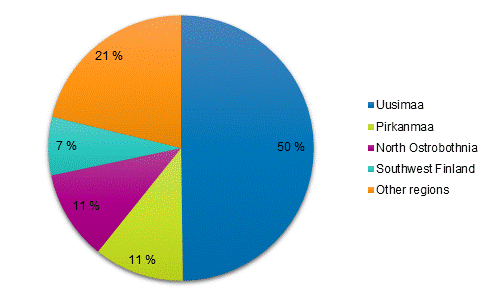
Government sector research is centred in Uusimaa, the region’s share of R&D expenditure in the sector was 70 per cent. Thirty-nine per cent of the research in the higher education sector was performed in Uusimaa. The shares of Southwest Finland and Pirkanmaa were 12 and 11 per cent and that of North Ostrobothnia nine per cent. Of enterprises’ R&D expenditure one-half was directed at Uusimaa. The shares of Pirkanmaa and North Ostrobothnia were 12 per cent each.
The higher education sector accounted for 25 per cent of the research input in the entire country, but the relative importance of the higher education sector on regional research varies strongly. The higher education sector accounted for around 60 per cent of R&D expenditure in South Savo and North Karelia, the share was also over one-half, or 53 per cent, in Lapland. By contrast, in Uusimaa and North Ostrobothnia, for example, the share of the higher education sector in R&D expenditure was around one-fifth.
Among the regions of Mainland Finland, R&D activity was most enterprise-driven in Ostrobothnia (enterprises’ share 86%) and in the regions of Kymenlaakso and Satakunta (80%).
1.4. Extramural R&D amounted to EUR 417 million
Extramural R&D activity (Appendix table 2, in Finnish) refers to entire R&D projects or undertakings contracted out by the enterprise or organisation, which are not service purchases or support functions of own R&D activities. The coverage of the collected data is limited, because the statistics on research and development relate to enterprises or organisations performing R&D activities, so units only contracting R&D are excluded.
A total of EUR 417 million of contracted research was reported, of which almost EUR 150 million from abroad. Enterprises’ purchases corresponded to 90 per cent of the whole volume. In the higher education sector, research is rarely contracted out. Domestic enterprises made up nearly one-half of service providers, or EUR 200 million. In this role, the higher education sector is also significant, as research services performed by domestic higher education institutions amounted to EUR 35 million.
1) Estimated based on survey responses and other calculations
2) OECD, Main Science and Technology Indicators, OECD figures for Finland may differ slightly from the nationally published
Source: Research and development 2019, Statistics Finland
Inquiries: Ari Leppälahti 029 551 3237, Heidi Pirkola 029 551 3246, tiede.teknologia@stat.fi
Head of Department in charge: Mari Ylä-Jarkko
Updated 29.10.2020
Official Statistics of Finland (OSF):
Research and development [e-publication].
ISSN=2342-6721. 2019,
1. Research and development 2019
. Helsinki: Statistics Finland [referred: 16.4.2024].
Access method: http://www.stat.fi/til/tkke/2019/tkke_2019_2020-10-29_kat_001_en.html

